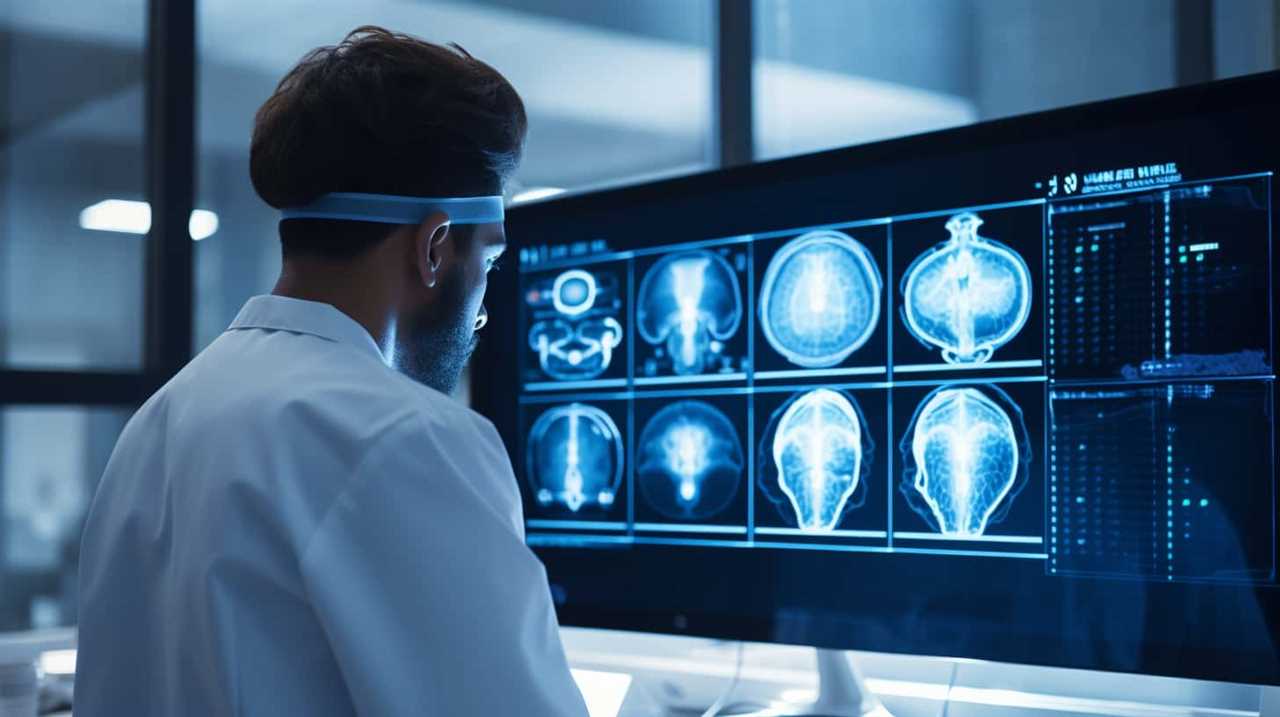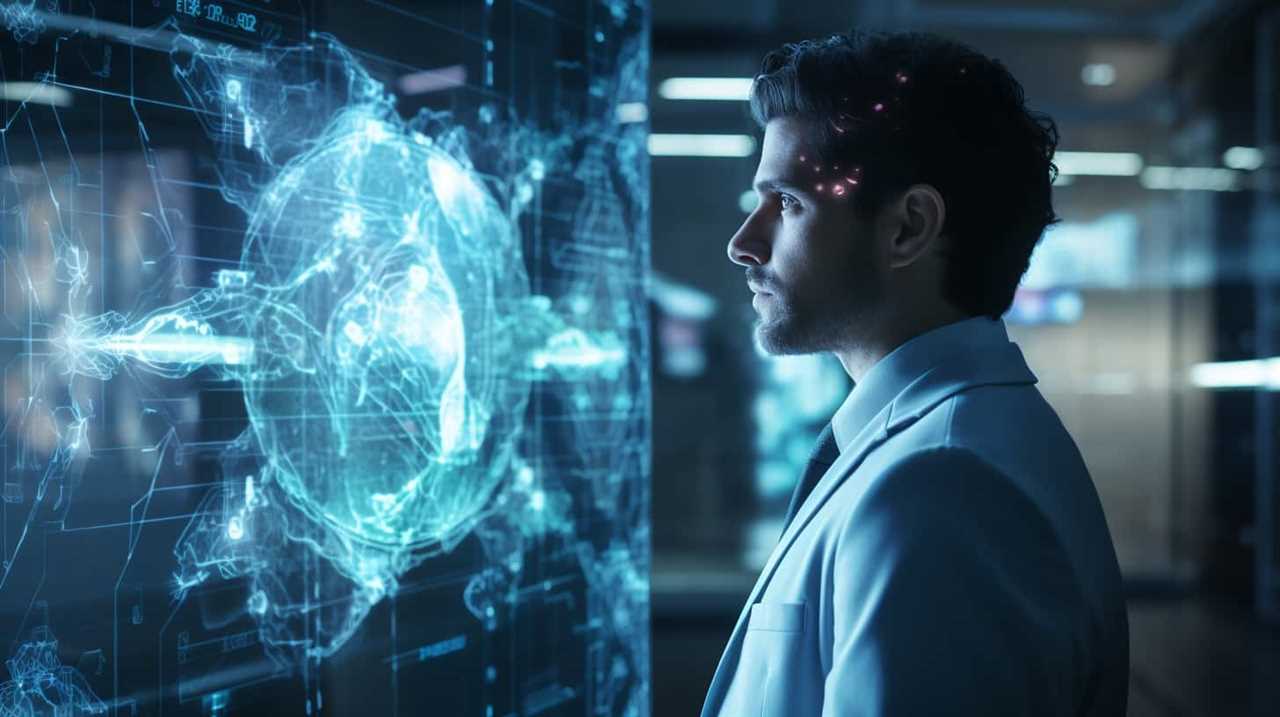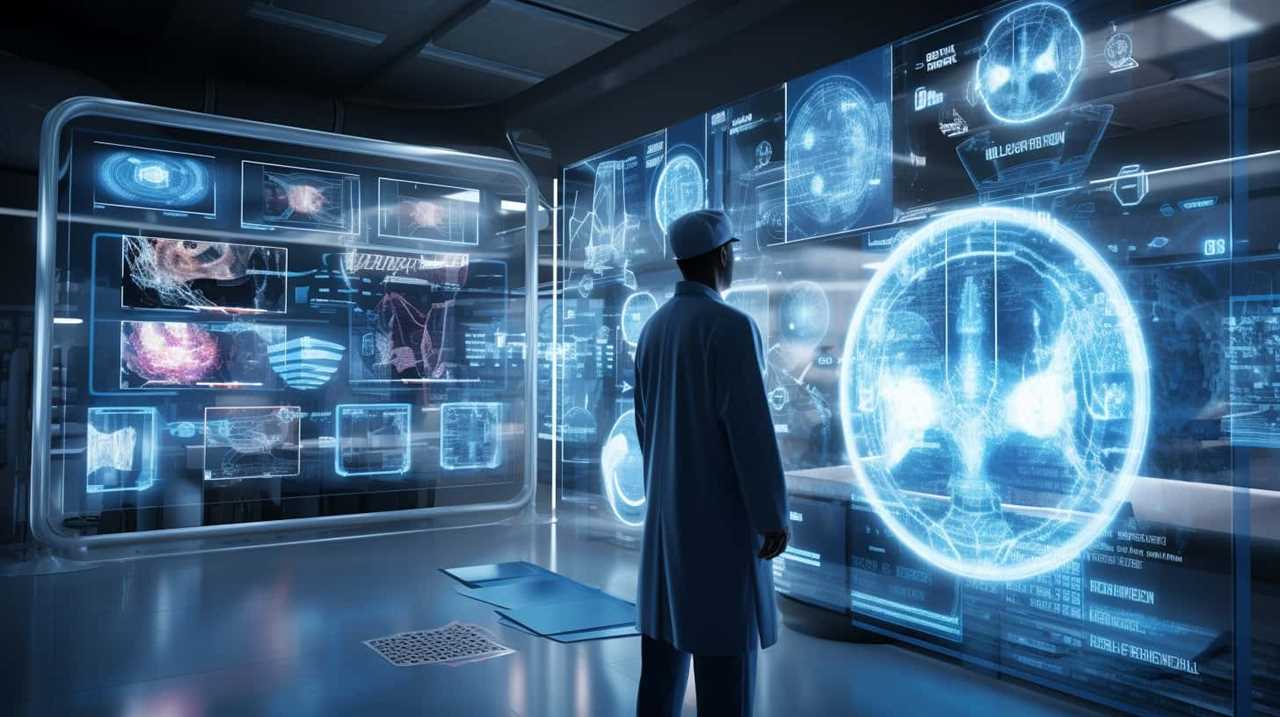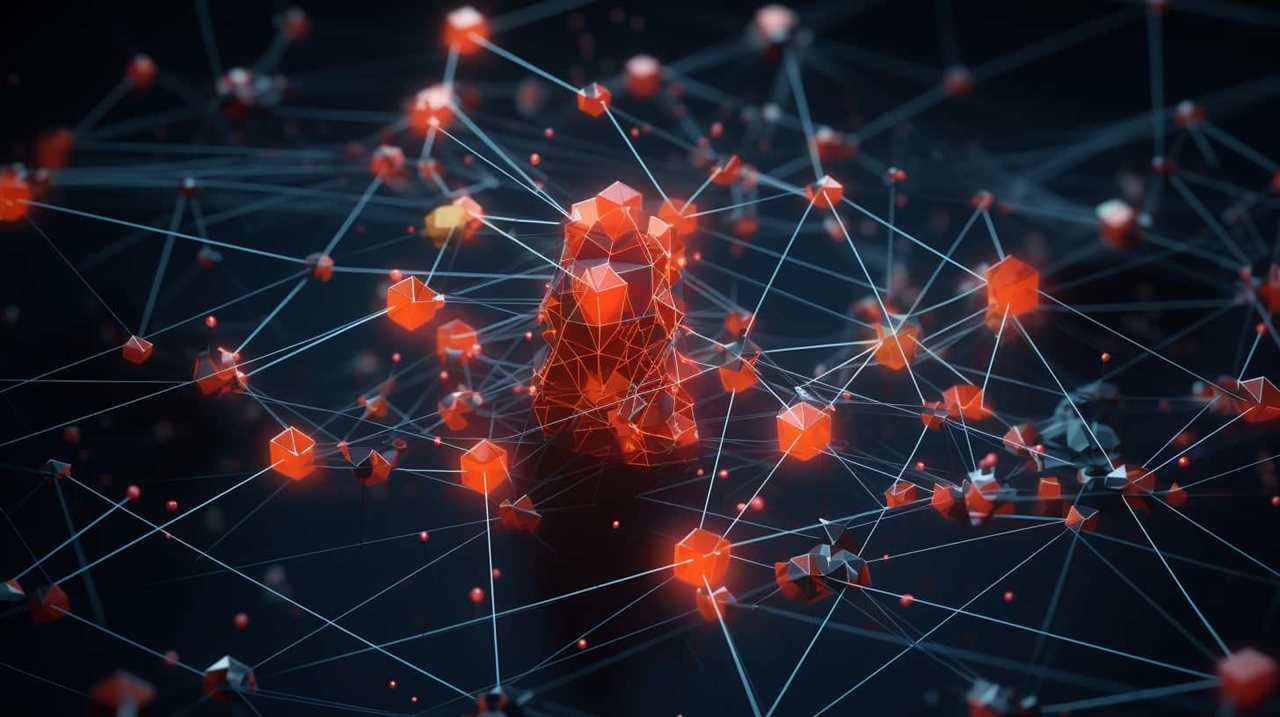We have the solutions to your immediate inquiries regarding the future of artificial intelligence in medical imaging.
Get ready to dive into the exciting advancements that are revolutionizing the field.
From enhanced accuracy and precision to real-time diagnosis and personalized treatment, medical imaging AI is set to transform healthcare as we know it.
Buckle up, because the future is here, and it’s bringing us closer to a new era of innovation and care.
Key Takeaways
- Enhanced accuracy and precision: Advancements in medical imaging AI improve the accuracy and precision of diagnoses and treatments by analyzing vast amounts of imaging data and identifying subtle abnormalities.
- Advanced imaging technology integration: Integration of advanced imaging technology with medical imaging AI enhances diagnostic capabilities through high-resolution imaging, multi-modal imaging, real-time imaging, and quantitative imaging.
- Real-time diagnosis and decision making: Real-time analysis and interpretation of medical images enable immediate treatment plans, informed decisions, and proactive treatment planning based on predictive algorithms.
- Personalized treatment and care: Medical imaging AI applies precision medicine techniques to customize healthcare interventions, identify effective treatment options, and aid in personalized treatment plans and preventive measures.

Enhanced Accuracy and Precision
In the future, we’ll see advancements in medical imaging AI that enhance the accuracy and precision of diagnoses and treatments. Machine learning algorithms and image recognition techniques will play a crucial role in achieving this goal.
By analyzing vast amounts of medical imaging data, these algorithms can learn patterns and trends that may not be readily apparent to human observers. This allows for more accurate and reliable diagnoses, leading to improved patient outcomes.
Additionally, machine learning algorithms can assist in the identification of subtle abnormalities that may be missed by the human eye, further enhancing the precision of diagnoses.
With continued research and development in this field, medical imaging AI has the potential to revolutionize healthcare by providing clinicians with powerful tools to make more accurate and precise diagnoses and treatment plans.

Advanced Imaging Technology Integration
We are integrating advanced imaging technology into medical imaging AI to further enhance diagnostic capabilities. This integration allows us to leverage the power of machine learning algorithms to analyze and interpret medical images with improved accuracy and precision.
Here are some key advancements in advanced imaging technology integration:
- High-resolution imaging: Advanced imaging technology enables the capture of high-resolution images, providing a detailed view of anatomical structures and abnormalities.
- Multi-modal imaging: By combining different imaging modalities such as MRI, CT, and PET, we can gather complementary information to improve diagnostic accuracy.
- Real-time imaging: The integration of advanced imaging technology with AI allows for real-time image acquisition and analysis, enabling faster and more efficient diagnosis.
- Quantitative imaging: Advanced imaging technology enables the extraction of quantitative data from medical images, facilitating objective and standardized assessment of diseases.
Through the integration of advanced imaging technology, medical imaging AI is poised to revolutionize diagnostics by providing more accurate and precise interpretations of medical images.

Real-time Diagnosis and Decision Making
Real-time diagnosis and decision making in medical imaging AI involves the rapid analysis and interpretation of medical images to inform immediate treatment plans. This process relies on real-time analysis and predictive algorithms to provide accurate and timely insights.
By leveraging advanced machine learning techniques, medical imaging AI can quickly analyze large volumes of image data and detect abnormalities or potential diagnoses in real time. This enables healthcare professionals to make informed decisions and take immediate action, resulting in improved patient outcomes.
Real-time analysis allows for faster and more efficient diagnosis, reducing the time patients spend waiting for results. Additionally, predictive algorithms can help clinicians anticipate potential complications or disease progression, enabling proactive treatment planning and personalized care.

Personalized Treatment and Care
Moving forward, our focus will shift towards discussing the subtopic of personalized treatment and care in medical imaging AI.
Personalized treatment and care refer to the customization of healthcare interventions to individual patients, taking into account their unique characteristics and needs. In the context of medical imaging AI, personalized treatment and care can be achieved through the application of precision medicine techniques.
Here are four key aspects of personalized treatment and care in medical imaging AI:
- Individualized Therapy: Medical imaging AI can help in identifying the most effective treatment options for each patient based on their specific condition. By analyzing imaging data, AI algorithms can assist in tailoring therapy plans that maximize treatment efficacy and minimize side effects.
- Precision Medicine: Medical imaging AI can contribute to the field of precision medicine by providing insights into the patient’s individual physiology and helping to determine the most appropriate course of action. This can lead to more targeted and effective treatments, improving patient outcomes.
- Predictive Modeling: AI algorithms can analyze medical imaging data to predict disease progression, response to treatment, and potential complications. This information can aid healthcare providers in making informed decisions about personalized treatment plans and preventive measures.
- Patient-Centered Care: Medical imaging AI can facilitate patient-centered care by enabling healthcare providers to consider the patient’s preferences, values, and goals when designing treatment plans. This approach ensures that the patient’s individual needs and priorities are taken into account, leading to improved patient satisfaction and overall healthcare outcomes.

Integration With Electronic Health Records
To further enhance personalized treatment and care in medical imaging AI, integration with electronic health records plays a crucial role. By integrating AI technologies with electronic health records (EHRs), healthcare providers can access comprehensive patient information, allowing for more accurate and efficient diagnoses. This integration enables AI algorithms to analyze a patient’s medical history, medication records, and previous imaging results, providing valuable insights for AI-assisted diagnosis. However, it is essential to prioritize data privacy and security when integrating medical imaging AI with EHRs. Stricter regulations and encryption techniques are necessary to safeguard patient information from unauthorized access and potential breaches. By maintaining a balance between technological advancements and data privacy, the integration of medical imaging AI with electronic health records can revolutionize healthcare delivery, improving patient outcomes and streamlining diagnostic processes.
| Benefits | Challenges |
|---|---|
| Improved accuracy and efficiency in diagnoses | Ensuring data privacy and security |
| Access to comprehensive patient information | Integration challenges between different EHR systems |
| Enhanced AI-assisted diagnosis | Maintaining data integrity |
| Streamlined diagnostic processes | Limited interoperability between AI and EHR systems |
| Potential for personalized treatment and care | Technical and logistical complexities |

Frequently Asked Questions
How Does Medical Imaging AI Improve Accuracy and Precision in Diagnosis?
Improving patient outcomes, medical imaging AI enhances accuracy and precision in diagnosis. It allows for more precise identification of abnormalities and assists in treatment planning. This improves efficiency and productivity in healthcare settings.
What Are Some Examples of Advanced Imaging Technology Integrated With Medical Imaging Ai?
In the future, we can expect advancements in imaging technology integrated with medical imaging AI. These advancements will revolutionize medical diagnostics and treatment by providing more accurate and precise imaging results for various medical applications.
How Does Real-Time Diagnosis and Decision Making Benefit Patients and Healthcare Providers?
Real-time diagnosis and decision making in healthcare benefits both patients and healthcare providers. Medical imaging AI plays a crucial role in improving patient outcomes and reducing errors by providing accurate and timely information for effective treatment strategies.
Can Medical Imaging AI Be Used to Personalize Treatment and Care for Individual Patients?
Yes, medical imaging AI can help personalize treatment and improve patient care. By analyzing vast amounts of data, AI algorithms can identify individual patient needs and provide tailored treatment plans for better outcomes.
How Does the Integration of Medical Imaging AI With Electronic Health Records Impact Healthcare Delivery?
The integration of medical imaging AI with electronic health records has a significant impact on patient outcomes. However, ethical considerations must be taken into account to ensure the responsible and effective use of this technology.

Conclusion
In conclusion, the future advancements in medical imaging AI hold great promise for enhancing accuracy and precision in diagnoses.
One interesting statistic is that a recent study found that AI algorithms were able to detect breast cancer in mammograms with an accuracy rate of 94.5%, compared to 88.2% for human radiologists.
This highlights the potential of AI to significantly improve the accuracy and efficiency of medical imaging, leading to better patient outcomes and personalized treatment options.









